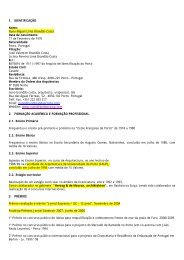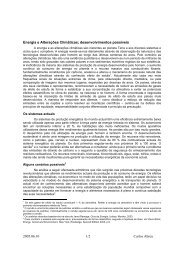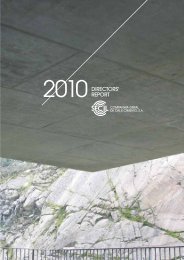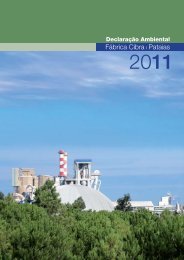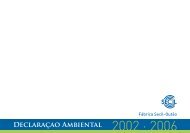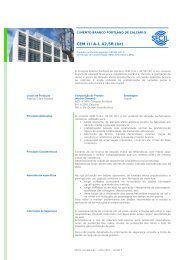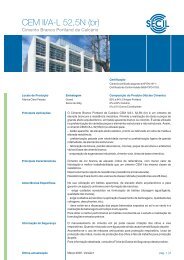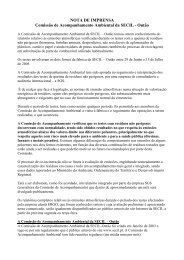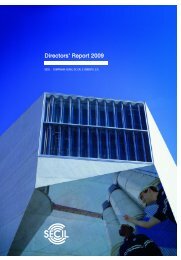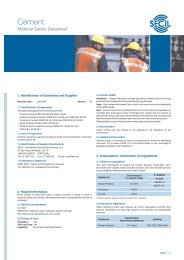5. - Secil
5. - Secil
5. - Secil
Create successful ePaper yourself
Turn your PDF publications into a flip-book with our unique Google optimized e-Paper software.
6.1.<br />
MACROECONOMIC<br />
BACKGROUND<br />
The most significant<br />
political development in<br />
Angola was the September<br />
elections to the<br />
National Assembly. This<br />
represented a further important<br />
step towards definitive<br />
stabilization of the<br />
sentiment of peace and<br />
towards continuation of<br />
the process of national<br />
reconstruction, which<br />
has reached all areas of<br />
Angolan territory and also<br />
sectors of activity.<br />
Despite the international<br />
financial crisis, the<br />
Angolan economy once<br />
again enjoyed significant<br />
growth in 2008 on the<br />
strength of the petroleum<br />
sector and thanks to the<br />
process of national reconstruction<br />
financed by<br />
external credit lines contracted<br />
mainly from China.<br />
The process of national reconstruction<br />
has levered growth in the non-petroleum<br />
sector, which in the last three years has presented<br />
healthy growth, in excess of that<br />
recorded by the oil sector. Overall, gross<br />
domestic product is thought to have grown<br />
in the order of 13%, slowing from the 2007<br />
rate of 18%.<br />
Oil output is expected to remain at high<br />
levels and to continue to support growth in<br />
the Angolan economy, despite a foreseeable<br />
decline in oil prices in 2009.<br />
Inflation stood at 12.6%, slightly higher<br />
than in 2007. Unlike the previous year, the<br />
Kwanza fell against the US dollar by approximately<br />
2.2%.<br />
<strong>Secil</strong>’s operations in Angola continue to<br />
be positively affected by the impact of the<br />
situation described above on demand for<br />
construction materials, whilst still suffering<br />
the effects of the structural constraints on<br />
6. Angola<br />
the supply side (availability of human resources<br />
with adequate training, transport, power<br />
supply, etc.).<br />
However, clinker prices on the international<br />
market and the increase in maritime<br />
freights in the first half had a significant<br />
impact on the operations of <strong>Secil</strong> Lobito<br />
and on the cement market in general.<br />
6.2. CEMENT<br />
Demand for cement continued to increase<br />
in 2008 thanks to sustained growth in the<br />
economy and execution of major national<br />
reconstruction projects. The market was<br />
supplied by national producers and also by<br />
cement imports, as the Angolan cement<br />
industry lacks the capacity to respond to<br />
overall requirements.<br />
<strong>Secil</strong> Lobito recorded sales of 295 000<br />
tons, in quantity, and 46 million €, in value,<br />
representing growth of 25% and 43% respectively,<br />
in relation to the previous year.<br />
<strong>Secil</strong>-Lobito Plant



